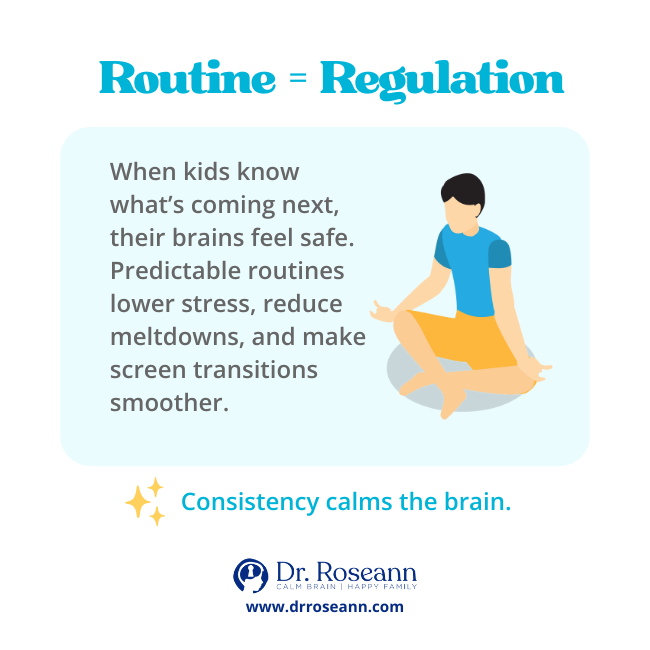Estimated reading time: 11 minutes
If every evening in your home feels like a battle over screens, you’re not alone. Parents tell me daily how exhausted they are from constant negotiations, meltdowns, and guilt around devices.
What most don’t realize is that screen struggles aren’t just about willpower — they’re about self-regulation.
When kids are overstimulated, their brains can’t shift easily between high dopamine rewards and calm focus.
In this blog, we’ll explore practical, science-backed ways to help your child develop healthier screen habits and better self-regulation skills.
Why Do Kids Struggle So Much with Screen Limits?
Screens give kids a burst of pleasure chemicals — especially dopamine. This makes them crave more, even when they know they should stop.
A parent I worked with, Sara, shared how her 11-year-old would melt down each time she turned off his tablet. Once we reframed it as a regulation issue, not a defiance one, things
shifted. With new routines and clear limits, his anxiety decreased and calm moments returned.
What Happens in the Brain During Screen Overuse?
Research shows that excessive screen exposure activates the brain’s reward centers much like sugar or gambling. A 2023 study in JAMA Pediatrics found that children who spent more than four hours a day on screens showed reduced prefrontal activation—the region responsible for decision-making and emotional control. The result? Difficulty transitioning and managing frustration when asked to unplug.
Parent Takeaway: The goal isn’t to eliminate screens, but to balance stimulation with real-world regulation.
How Can You Set Clear Screen Time Boundaries?
Boundaries work best when they’re predictable. Instead of sudden cutoffs, use structured routines: for example, 30 minutes of gaming after homework and 10-minute transition reminders.
Strategy | Why It Works | Example |
Visual timers | Builds predictability and reduces resistance | Kitchen timer or visual countdown app |
Device-free zones | Helps kids connect and reset | No phones at dinner or bedtime |
Collaborative rules | Increases buy-in | Involve kids in deciding screen-free times |
What Role Does Routine Play in Reducing Screen Conflicts?
Kids thrive when they know what to expect.
Establish a daily rhythm that includes screen time and plenty of off-screen regulation breaks.
For example, one dad, Marcus, built a Saturday schedule with chores, outdoor play, and an hour of gaming. The fights disappeared within weeks because the plan was clear and consistent.
Therapist Insight: Consistency calms the nervous system. When transitions are predictable, kids feel safe enough to cooperate.

How Can Parents Model Healthy Digital Behavior?
Children learn from what they see, not what we say. If you’re constantly checking your phone, they notice. Practice small changes—put your phone away during meals or when you first get home. When your child sees you self-regulate, they internalize that balance.
Try This: Use a family charging station to create shared accountability.
Brain Science Spotlight: Dopamine, Screens, and Self-Regulation
Recent research from Stanford University (2022) found that constant exposure to fast-paced digital stimuli floods the brain with dopamine, disrupting natural reward pathways. Dr. Anna Lembke, author of Dopamine Nation, explains, “When dopamine spikes repeatedly, the brain compensates by reducing its sensitivity to pleasure.” This explains why your child may seem bored or irritable without screens.
What this means for your family:
To restore balance, kids need low-dopamine activities like movement, mindfulness, and creative play to rebuild regulation pathways.
What Are Some Effective Alternatives to Screens?
Replace, don’t just remove. Encourage sensory-rich, engaging activities that help regulate the brain and body.
Here are a few ideas:
- Nature walks or biking
- Building with Legos or art projects
- Cooking or baking together
- Family game night
- Breathing or mindfulness exercises
Parent Example:
When Tina swapped her son’s afternoon YouTube time with a daily walk and puzzle time, his mood stabilized, and tantrums decreased.
How Can You Support Your Child’s Emotional Regulation?
Screens can hijack the nervous system, making it harder for kids to manage big feelings. Support regulation by:
- Naming emotions (“I see you’re frustrated that it’s time to stop”)
- Offering sensory tools (fidgets, weighted blankets, movement)
- Practicing co-regulation — calm yourself first, then connect
When kids feel seen and supported, they can access their logical brain instead of spiraling into fight-or-flight mode.
Dr. Roseann’s Therapist Tip
In my 30+ years of clinical practice, I’ve learned that screen battles are really about brain balance.
Try this today:
Build in a 15-minute regulation break before and after screen time.
Why it works:
It gives the nervous system time to shift gears, reducing irritability and meltdowns. Remember: Small daily changes lead to calmer brains.
How to Stay Consistent When Screen Rules Break Down
You’ll have setbacks—that’s okay. When rules are broken, stay calm and reset together. Revisit agreements, not punishments. Model flexibility and self-control. One parent told me, “Once I stopped yelling and started problem-solving, our evenings transformed.”
Consistency and compassion create real change.
Parent Action steps:
- Begin with one 15-minute “tech-free reset” each day—consistency beats perfection.
- Keep phones out of bedrooms and dinner tables to show calm, intentional tech use.
- Notice and praise when your child transitions off a screen calmly—reinforcement rewires the brain faster than correction.
- Join our Natural Parenting Solutions Facebook Group to connect with other parents who truly get it.
- Subscribe to The Dysregulation Insider Newsletter for weekly science-backed tips.
The American Academy of Pediatrics recommends no more than 2 hours of recreational screen time per day for school-aged children, emphasizing quality content and supervision.
Stay calm and stick to established boundaries. Use visual timers, give transition warnings, and offer engaging off-screen alternatives.
Yes. Studies show that excessive screen time can increase stress and anxiety by overactivating the nervous system and reducing dopamine sensitivity.
Involve them in the decision-making process. Discuss how screens affect mood and focus, and encourage daily self-regulation routines like exercise or journaling.
Citations:
American Academy of Pediatrics. (2023). Media and Young Minds: Updated Guidance for Families. Pediatrics. https://doi.org/10.1542/peds.2023-060123
Paulus, M. P., et al. (2023). Neural correlates of screen media activity in youth. JAMA Pediatrics, 177(2), 175–183. https://doi.org/10.1001/jamapediatrics.2022.4817
Twenge, J. M., & Campbell, W. K. (2022). Associations between screen time and mental well-being in adolescents. Computers in Human Behavior, 130, 107190. https://doi.org/10.1016/j.chb.2022.107190
Dr. Roseann Capanna-Hodge is a licensed mental health expert that is frequently cited in the media:
- Family News.io How Can Parents Set Boundaries for Screen Time?
- The Washington Post Worried about your kids’ screen time? Check your own first.
- GoSolo by Subkit Calm Brain, Happy Family – Dr. Roseann Capanna-Hodge
Disclaimer: This article is not intended to give health advice and it is recommended to consult with a physician before beginning any new wellness regime. *The effectiveness of diagnosis and treatment vary by patient and condition. Dr. Roseann Capanna-Hodge, LLC does not guarantee certain results.
Are you looking for SOLUTIONS for your struggling child or teen?
Dr. Roseann and her team are all about science-backed solutions, so you are in the right place!










